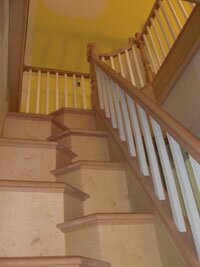GREEN- Steep but safe: Alternating treads save history... and space

The alternating tread staircase conserves space and provides a unique alternative to a ladder or spiral staircase.
PHOTO BY MATTHEW MERKLE
They say the greenest building of all is the one that's not demolished because it can't adapt. And of all the challenges a builder faces rehabbing an old house, one of the greatest is meeting modern code requirements without demolishing the homeowner's taste and budget.
Such was the challenge presented to Ivy-based carpenter Matthew Merkle, who was tasked with replacing an extremely steep staircase in a Keswick cottage.
The owners wanted to preserve the 18th century structure with a complete renovation. Attempting to preserve the building's structural integrity meant they didn't want to knock down exterior walls to make more room for stairs.
"The existing staircase was rickety," says Merkle, "as it predated any sort of code, a glorified ladder– very haphazard."
Because the hallway in which the stairs land is only five-feet wide and under eight feet deep, Merkle quickly ruled out a spiral staircase (too large) and a conventional staircase (too steep).
"I wasn't sure what I was going to do," he says.
Code prohibits ladders from serving as the sole access point to regularly used living space, so Merkle was initially stumped. But after spending hours researching possible solutions, he found his answer on a naughty-sounding website, stairporn.org.
There he saw her, a hybrid of stair and ladder: the alternating tread staircase.
More common in Europe, where small living spaces are common, alternating treads haven't exactly caught on in code-conscious America. In fact, the alternating tread staircase is so rare that Merkle estimates there are less than a dozen in the entire country.
While traditional stairs require as much as 10 inches of depth and six or seven inches of height per step, alternating treads pack in more climb in less depth– and without feeling so steep.
Would Albemarle County accept the solution?
Not at first, says Merkle. But after he presented the results of a late 1980s study conducted at Virginia Tech that supports the notion that alternating tread staircases are safer than ladders, the County brass acquiesced.
Even with his code variance secured, Merkle's challenge wasn't over: because such staircases are so rare, there are no models on which to base the design.
Merkle, who says he enjoys the "puzzle" element of carpentry, spent a full week designing the stairs and figuring out how to assemble his creation. Actual construction took another week, and while the final stains haven't yet been applied, the project's general contractor– John Cargile of Heartwood Corporation– is delighted with the result in spite of a price tag that reached $8,500.
"They're inventive and beautiful," says Cargile. "I couldn't be happier."

Although steeper than traditional stairs, a study conducted at Virginia Tech concludes alternating tread staircases are safer than ladders.
PHOTO BY MATTHEW MERKLE
#